#pliestocene pride
Text
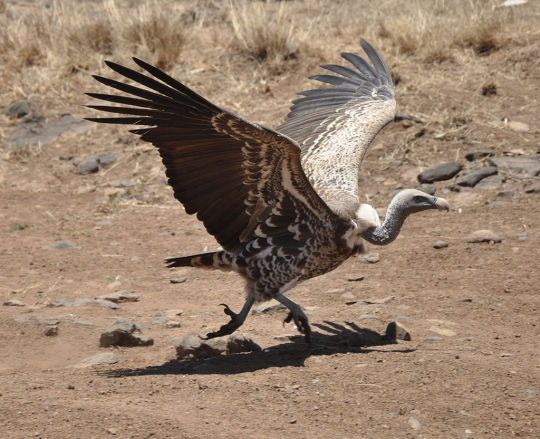
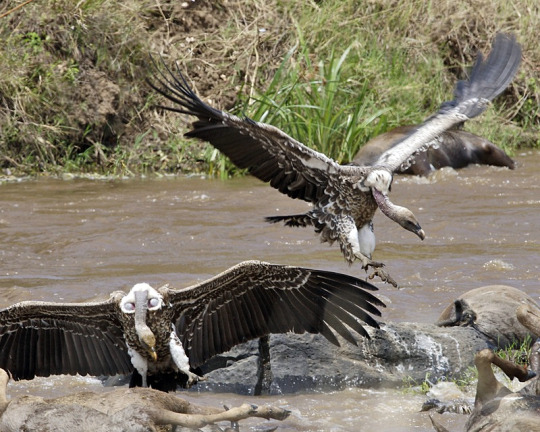
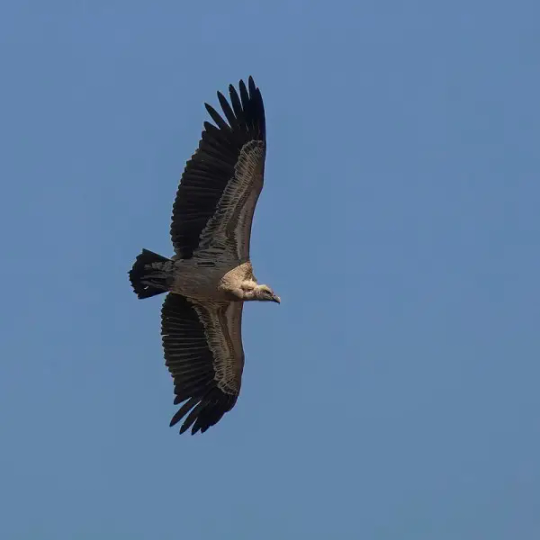
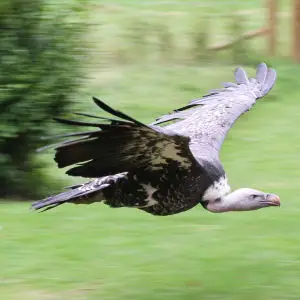

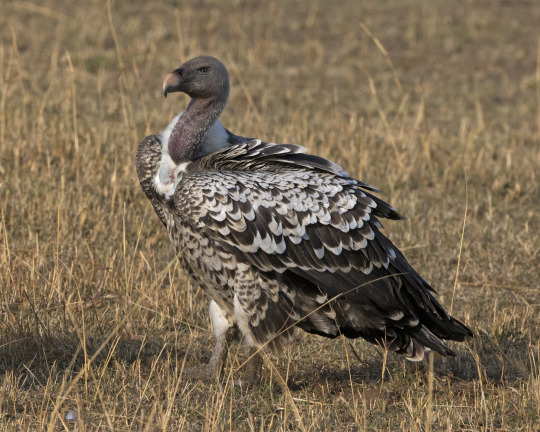
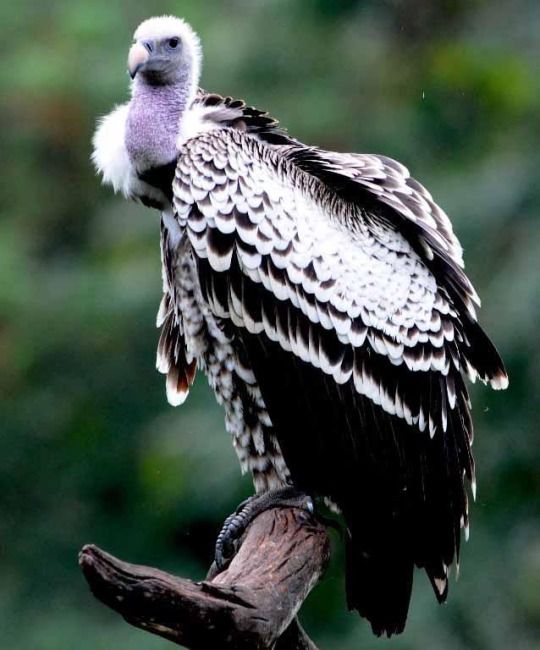
Rüppell's vulture also called Rüppell's griffon vulture, named after Eduard Rüppell, is a large bird of prey in the genus Gyps which is native throughout the sahel and eastern Africa including the countries of Algeria, Benin, Burkina Faso, Burundi, Cameroon, the Central African Republic, Chad, The Ivory Coast, Djibouti, Eritrea, Ethiopia, Gambia, Ghana, Guinea, Guinea-Bissau, Kenya, Mali, Mauritania, Niger, Nigeria, Rwanda, Senegal, Somalia, South Sudan, Sudan, Tanzania, Togo, and Uganda. Here they tend to inhabit grasslands, mountains, and open woodland. Rüppell's vultures are diurnal and very social birds, roosting, nesting, and feeding in large flocks. They spend much of their time flying at great altitudes, using strong winds and thermals to efficiently soar they are known to regular cruise at upwards of 20,000ft (6,000m) above the ground with some known to go as high as 37,000ft (11,300m) making them the highest flying bird. These vultures locate food by sight only, and often follow herds of animals. Once they find a carcass they swoop down, land a little way off, then bound forward with wings spread and their long neck outstretched. Even amongst old world vultures, Rüppell's vultures are specialized feeders with a spiked tongue and strong beak they can strip flesh with ease, and feed upon pelts, hides, and even the bones themselves. Reaching around 33 to 41in (85 -103cms) long, 14 – 20lbs in weight, with a 7.5-8.6ft (2.26 -2.6m) wingspan. They are one of the largest vultures in Africa, both sexes sport mottled brown or black feathering overall with a whitish-brown underbelly and thin, dirty-white fluff covering the head and neck. The base of the neck has a white collar, the eye is yellow or amber, the crop patch deep brown. The head does not have feathers. This species of vulture is considered to be monogamous, forming lifelong breeding pairs. They nest on cliffs in colonies up to a 1,000 strong. After courtship a pair will work together to build a nest using sticks, grass, and leaves that they have gathered or stolen from other nests, here the mother will lay 1 egg. Both parents share in incubation of their egg over a period of 55 days. Once the chick hatches, both parents will feed and tend to it for about 150 days when it fledges. Young remain dependent on their parents after fledging, not reaching independence until the next breeding season. Under ideal conditions a ruppells vulture may live up to 50 years.
#pleistocene#pleistocene pride#pliestocene pride#pliestocene#bird#dinosaur#vulture#ruppells vulture#africa#asia#europe#eurasia#flying#griffon#griffin#griffon vulture
436 notes
·
View notes
Photo
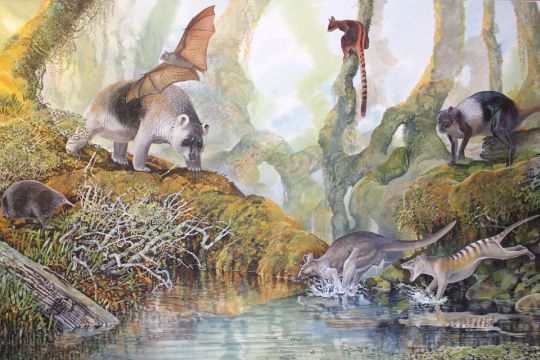
Ice Age Australia
#ice age#stone age#australia#bat#stonepunk#stone punk#wallaby#tasmania#tasmanian tiger#thylacine#echidna#wombat#diprotodon#tree kangaroo#kangaroo#pliestocene#pliestocene pride
62 notes
·
View notes
Text
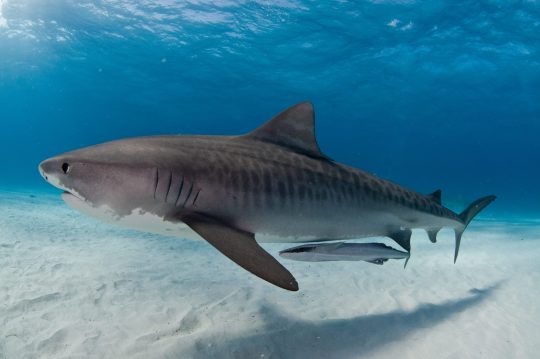
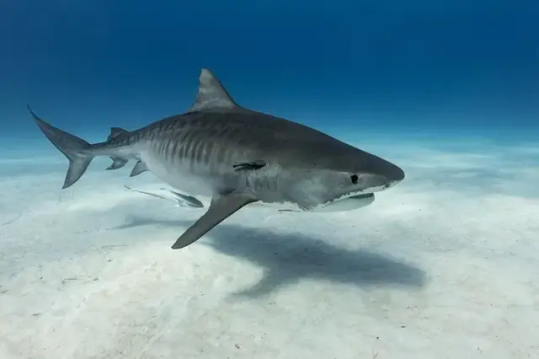

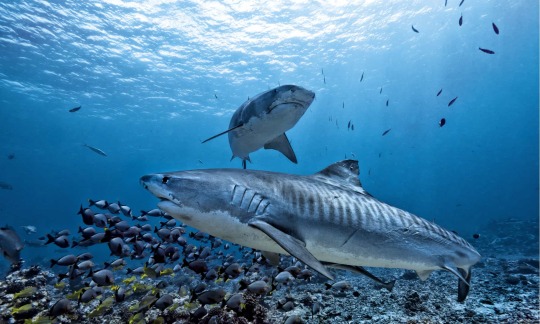
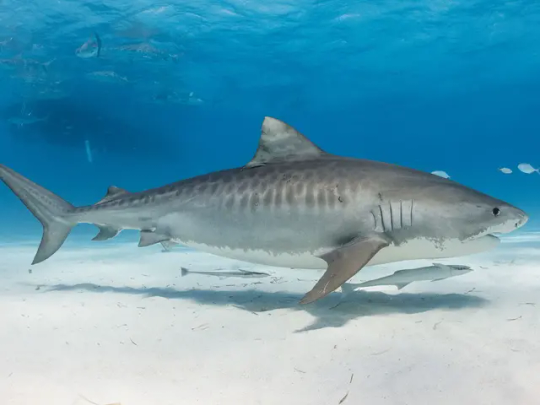
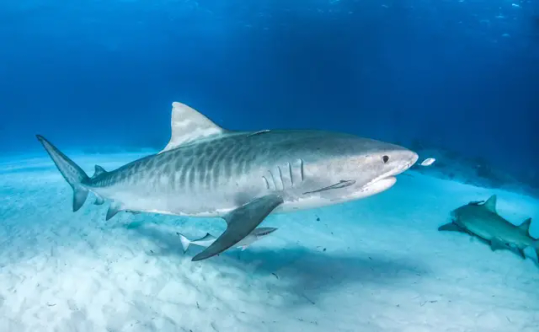
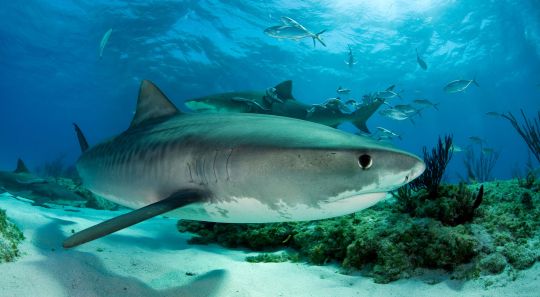
The tiger shark is a species of ground shark, and the only extant member of the genus Galeocerdo and family Galeocerdonidae. It is a highly nomadic species which inhabits tropical and subtropical waters world wide up to 3,000ft (900m) in depth, and is often found in coastal waters with particular abundance in the gulf of mexico, Caribbean sea, Indian ocean, and western pacific. Tiger sharks are often call the garbage cans of the sea and have reputation for eating almost anything. As such there diet is wide and heavily varied an is known to regularly include: small fish, jellyfish, crustaceans, cephalopods and other mollusks, rays, skates, sawfish, sea birds, sea snakes, sea turtles, other sharks, dolphins, seals, sea lions, dugongs, manatees, crocodilians, porpoises, and sick or injured whales. When near islands or coastlines they have been known to eat sheep, goats, dogs, pigs, rats, horses, deer, cattle, cats, camels, monkeys, inland birds, bats, lizards and inedible objects, such as license plates, cans, tires, books, boat oars, soccerballs and baseball bats. Tiger sharks are themselves occasionally preyed upon by orcas, great whites, and saltwater crocodiles. The tiger shark commonly reaches 10.5-14ft (3.2 -4.26m) in length and 385- 1400lbs (175 – 635kg) in weight, with the largest recorded reaching 18ft (5.5m) long and 3360lbs (1525kg). This ranks the tiger shark amongst the largest extant sharks on earth only being surpassed by the whale, basking, great white, pacific sleeper, Greenland, and blunt nosed sixgill sharks. They have a broad snout and stocky body with proportionally large fins and a long upper tail. Tiger shark teeth are unique with very sharp, pronounced serrations and an unmistakable sideways-pointing tip. Such dentition has developed to slice through flesh, bone, and other tough substances such as turtle shells. In the northern hemisphere the mating season takes place from march to may and the southern hemisphere from November to January, with males breeding every year while females breed once every 3 years. After a year long pregnancy mother tiger sharks give birth to 10 to 80 pups. Under ideal conditions a tiger shark may live upwards of 12 years.
#pleistocene#pleistocene pride#pliestocene pride#pliestocene#fish#shark#shark week#tiger#tiger shark
210 notes
·
View notes
Text
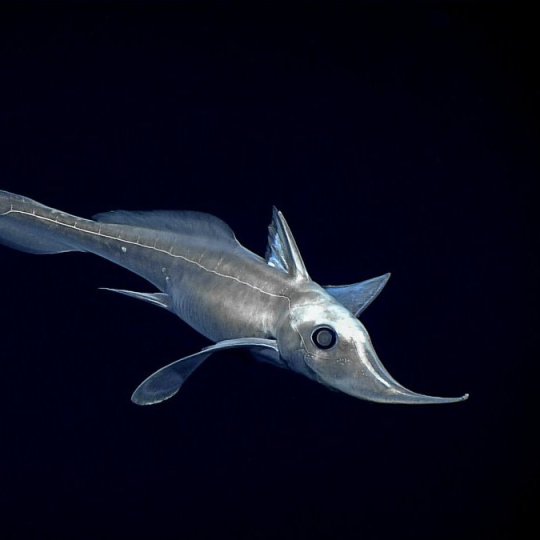

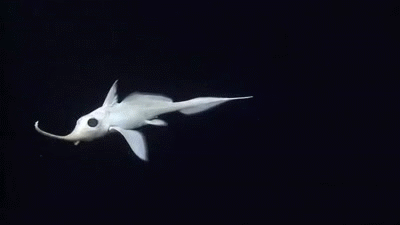
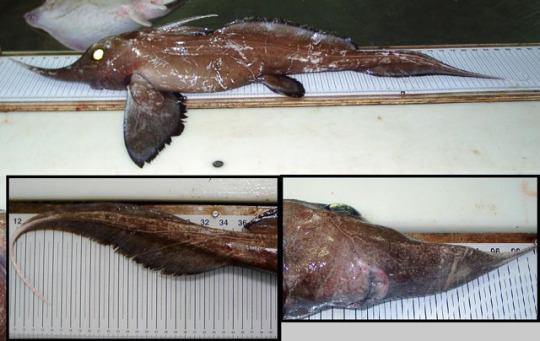

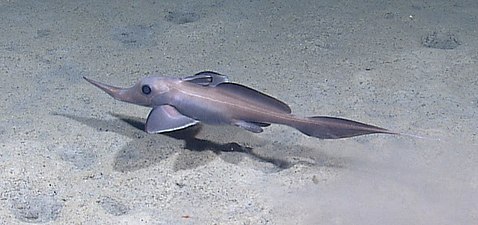
The narrownose chimaera (Harriotta raleighana) also know as the ghost shark or the spook fish is a longnose chimaera of the family Rhinochimaeridae which is native throughout temperate oceans worldwide and is typically found at depths of between 650ft (200m) and 10,200 (3,100m). Longnose chimaeras are members of the class Chondrichthyes, diverging from their closest relatives (sharks, rays, and skates) during the devonian period approximately 400 million years ago. Not much is known about there deep sea life style but they appear to feed upon crustaceans, worms, small fish, mollusks, and enchinoderms. They are themselves preyed upon by large sharks, boney fish, and large predatory squids & octopus. Female narrownose chimera are typically larger reaching around 4.9ft (1.5m) compared to males which reach around 3.3 (1m) in length. Both sexes sport elongate rostra, slender filamentous tails, large pectoral and pelvic fins, big eyes, and two dorsal fins, the first being preceded by a mildly poisonous spine. They can range in color from pale marbeled brown to dusty grey to ghostly white or a mixture of those colors. Like many other Chondrichthyes, longnose chimaeras reproduce by laying eggs. Egg cases consist of a central chamber surrounded by a web-like structure. Female longnose chimaeras lay a pair of eggs several times per year.
#pleistocene#pleistocene pride#pliestocene pride#pliestocene#fish#extant#narrownose chimera#chimera#shark week#shark#longnose#narrownose#Harriotta raleighana#spookfish#ghostfish#ghost shark#ghost#spook#ratfish#rat#deep sea
202 notes
·
View notes
Text

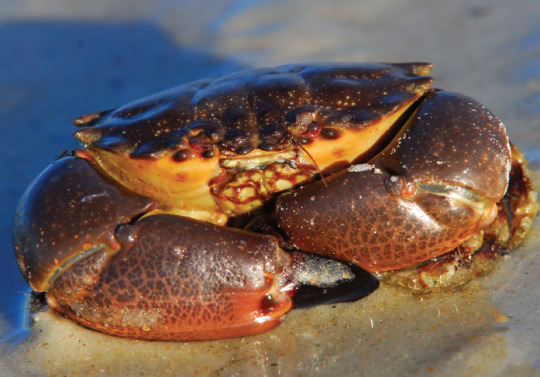


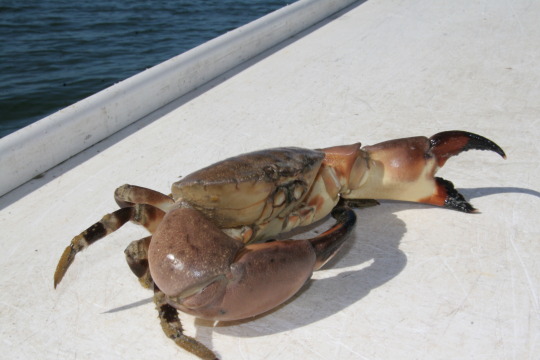

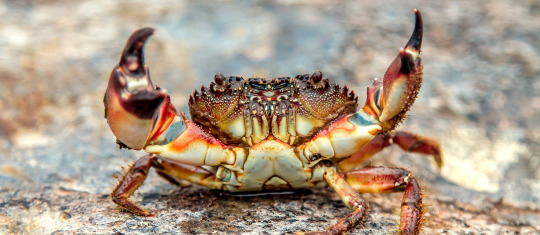
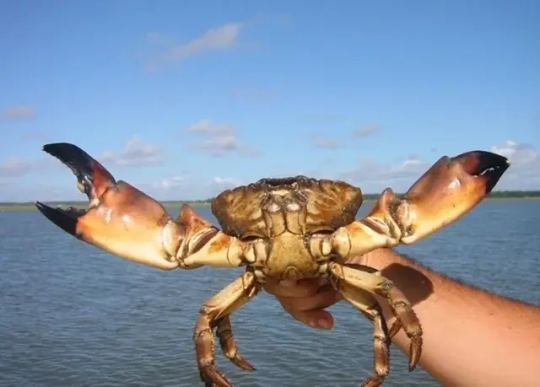
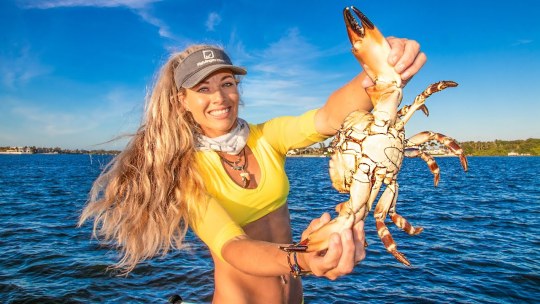


The Florida stone crab (Menippe mercenaria) is a species of true crab native to the coastal waters and salt marshes of the western North Atlantic, from Connecticut to Colombia, including throughout the Caribbean and Gulf of Mexico. Stone crabs typically inhabit shallower waters some 1 to 6.5ft (.3 to 2m) deep often digging and residing in holes on the ocean bottom, oyster reefs, docks, jetties, or rock mounts. Here they tend to spend there days, emerging usually at night to feed up on oysters and other small mollusks, sea grass, carrion, polychaete worms, and other crustaceans. Reaching around 5 to 6.5 inches (125 to 165mm) in carapace length, stone crabs are sexually dimphoric with males growing proportionally larger claws while females tend to reach larger sizes overall. Both sexes are brownish red in coloration with gray spots and a tan underside, sporting large black tipped claws. The Florida stone crab loses its limbs easily to escape from predators or tight spaces, but their limbs will grow back. When a claw is broken such that the diaphragm at the body/claw joint is left intact, the wound will quickly heal itself and very little blood is lost. If, however, the claw is broken in the wrong place, more blood is lost and the crab's chances of survival are much lower. Each time the crab molts, the new claw grows larger. The breeding season of the Florida Stone Crab lasts the whole of spring and summer. The male Florida stone crab must wait for the female to molt her exoskeleton before they can mate. After mating, the male will stay to help protect the female for several hours to several days. The female will spawn four to six times each season, producing up to a million eggs total. The larvae go through six stages in about four weeks before emerging as juvenile crabs, continuing to molt and grow they reach sexual maturity at about 2 years of age. Under ideal conditions a Florida stone crab may live upwards of 8 years.
#pleistocene#pleistocene pride#pliestocene pride#pliestocene#cenozoic#florida#stone crab#crab#florida stone crab#sea life#ocean#crustacean
59 notes
·
View notes
Text
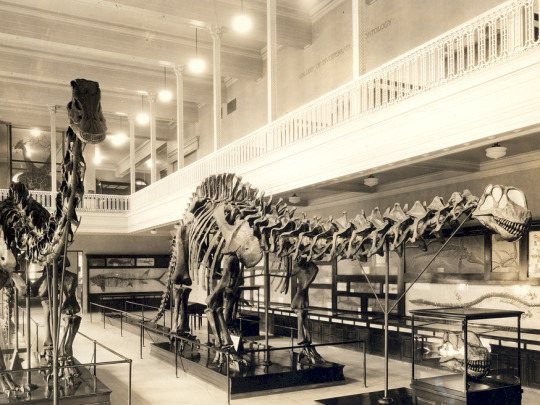
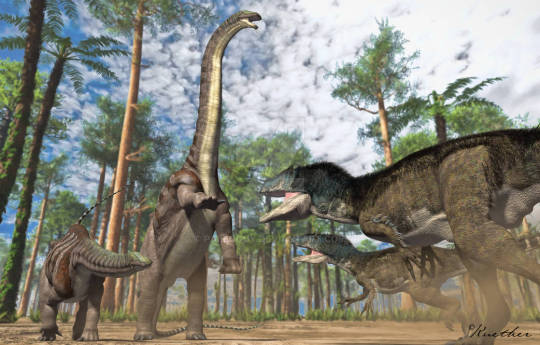



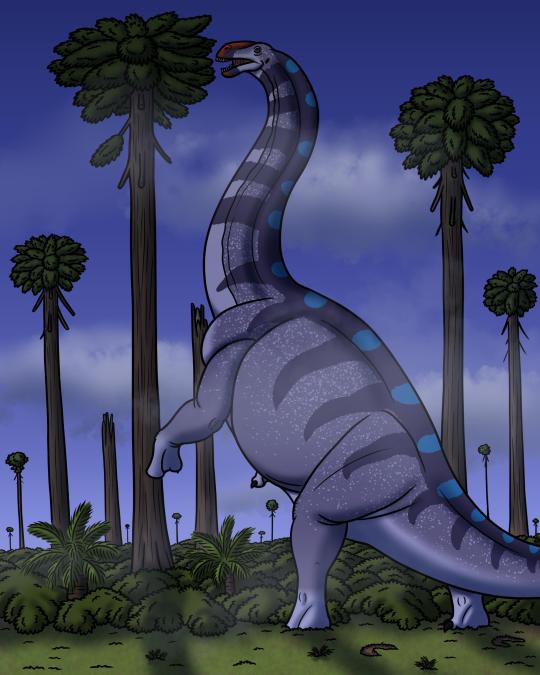



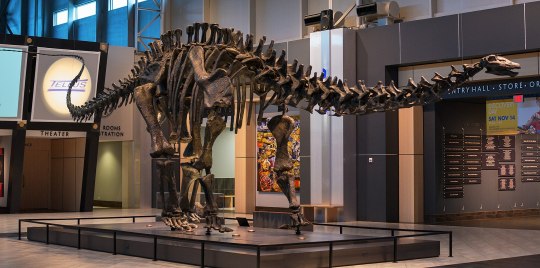
Happy Fossil Day. Happy Fossil Day! Brontosaurus is a genus of herbivorous sauropod dinosaur that lived in North America during the Late Jurassic period some 156 to 146 million years ago. The first remains consisted of a fairly complete skeleton was recovered from Como Bluff Wyoming in 1879 by William Harlow Reed who named its Brontosaurus excelsus, meaning "thunder lizard", from the Greek brontē meaning "thunder" and sauros meaning "lizard", and from the Latin excelsus, meaning "noble" or "high". Despite being one of the most complete sauropod skeletons known at the time, the brontosaurus type specimen along with another found in 1880 lacked skulls. In 1903 Elmer S. Riggs argued that Brontosaurus was so similar to Apatosaurus that it should become a synonym. However, when the first skeleton of Apatosaurus was mounted in the American Museum of Natural History in 1905, it bore the name Brontosaurus, in additional confusion because no skulls where known from these animals a faximilally was constructed based off of other sauropod skull remains now know to be Camarasaurus and brachiosaurs which gave the mount a truly bizarre head. This one mounted skeleton is the reason why so much controversy would exist for this dinosaur over the next hundred years. It was not until a 1975 study by John Stanton McIntosh and David Berman re-describing the skull and jaws of Apatosaurus and Diplodocus was published that things would really get moving for more accurate reconstructions. In 1995 the original Brontosaurus mount from 1905 finally got a skull revision to be like that of Apatosaurus, and was also now named as Apatosaurus excelsus. It took the best part of a century to reveal the true shape and form of Apatosaurus, and for most of this time the majority of paleontologists agreed with the opinion of Elmer S, Riggs from 1903 that Brontosaurus should be a synonym to Apatosaurus. One notable exception however was Robert T. Bakker, who in 1998 argued that Apatosaurus and Brontosaurus were distinct. Bakker would be proven right in 2015 when an extremely in-depth sauropod study conducted by Emanuel Tschopp, Octavio Mateus and Roger Benson found that the Brontosaurus type species B. excelsus was infact a valid genus. Reaching 62 to 72 (19 -22m) in length and 30,000 to 38,000 (13,600 -17,250kgs) in weight, brontosaurus was large, long-necked, and quadrupedal with a long tail terminating in a whip-like structure. The cervical vertebrae are notably extremely robust and heavily-built, in contrast to its lightly built relatives Diplodocus and Barosaurus. The forelimbs were short and stout whereas the hindlimbs were elongated and thick, all signs that brontosaurs was remarkably strong and muscular. Brontosaurus would have likely lived in loose herds acting as a nonselective browser feeding upon ferns, cycads, ginkgos, and horsetails, as it coexisted with with a menagerie of other morrison taxa such as the Diplodocus, Barosaurus, Brachiosaurus, Stegosaurus, Dryosaurus, Camptosaurus, Allosaurus, Torvosaurus, and Ceratosaurus.
Art Used in this video belongs to the following creators
Brontosaurus excelsus: Paleoguy
https://www.deviantart.com/paleoguy/art/Brontosaurus-excelsus-526754288
https://www.deviantart.com/paleoguy/art/Brontosaurus-780543420
https://www.deviantart.com/paleoguy/art/Brontosaurus-Allosaurus-570575957
Brontosaurus is Back: tuomaskoivurinne
https://www.deviantart.com/tuomaskoivurinne/art/Brontosaurus-is-back-526656913
Brontosaurus through the ages: Nix Draws Stuff
https://nixillustration.com/tag/brontosaurus/
#pleistocene pride#pliestocene pride#jurassic period#jurassic#dinosaur#dinosaurs#sauropod#brontosaurus#apatosaurus#fossil#fossil day#history#paleontology#mesozoic
74 notes
·
View notes
Text
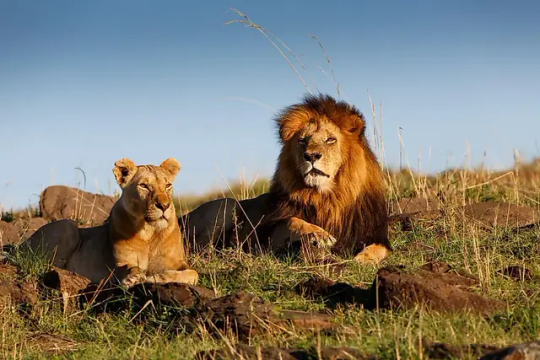



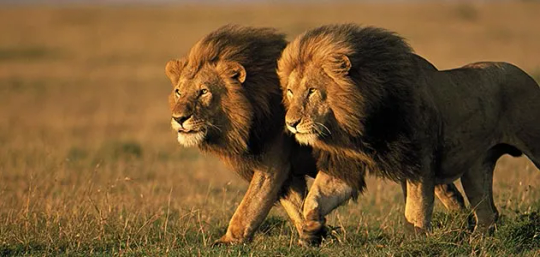
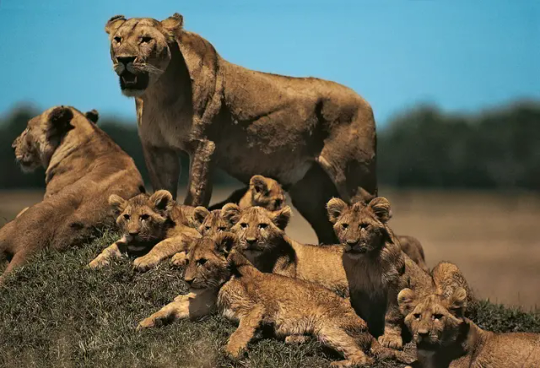



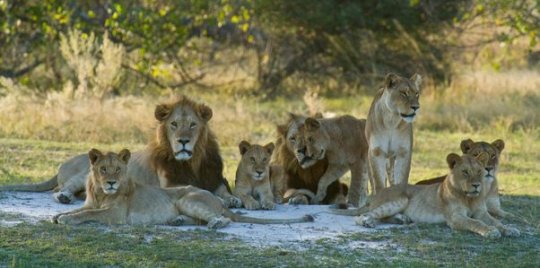
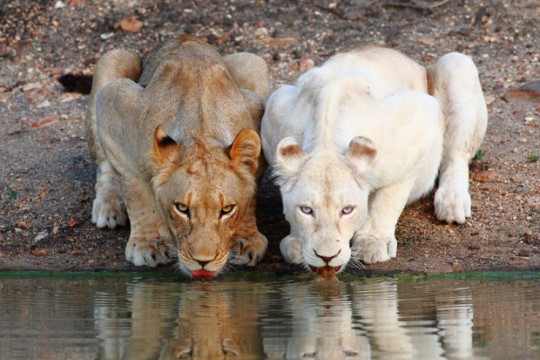
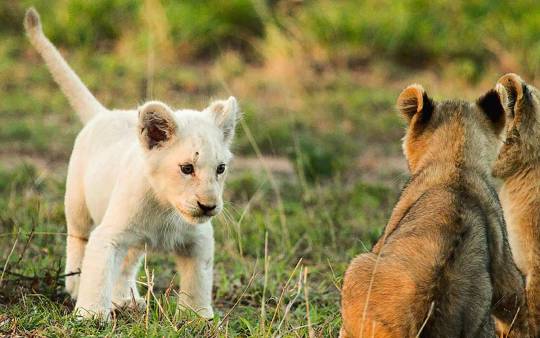
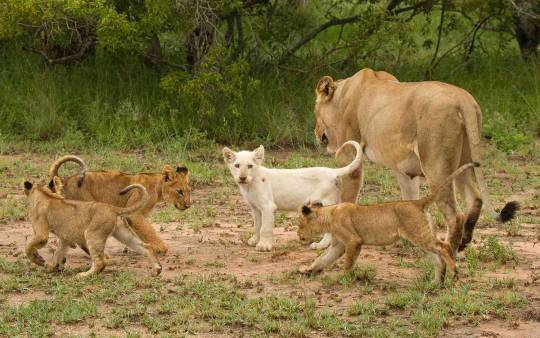
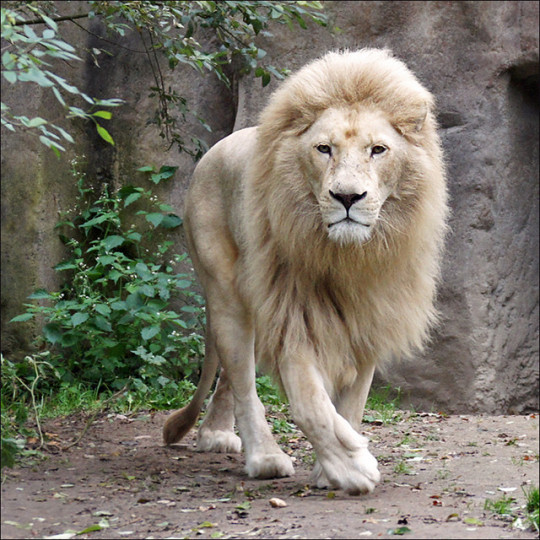
Panthera leo melanochaita better known as the east African lion, the Southern lion, the Southern African lion, or the East-Southern African lion,, is a subspecies of lion native to eastern and southern Africa. Here they prefer to inhabit grasslands and savannas, but are also known to inhabit open woodland, scrublands, and montane forests. African lions are the most social of all wild felines, living in groups of related individuals and their offspring called prides which number 3 to 30 females and 1 to 4 males. East African lions typically prey upon ungulates such as wildebeest, cape buffalo, eland, gemsbok, nyala, roan and sable antelope, warthogs, bush pigs, zebra, tsessebe, waterbuck, kudu, hartebeest, kob, and thomson’s gazelle, however they are also known to hunt other prey from as small as common mice to as large as young or infirm African bush elephants. Lions are themselves occasionally killed by other predators such as wild dogs, hyenas, leopards, other lions, and crocodiles. Female east African lions average around 7.5 to 8.9ft (2.3 to 2.7m) in length, and 183 to 370lbs (83 to 168kgs) in weight while males average around 8.1 to 9.4ft (2.47 to 2.84m) in length and 321 to 496lbs (145 to 225kgs) in weight, however lions as big as 11ft (3.35m) and 825lbs (375kgs) have been known to exist. This marks the lion as the second largest extant cat after the tiger. The lion is a muscular, broad-chested cat with a short, rounded head, a reduced neck, and round ears. The fur varies in color from light buff to silvery grey, yellowish red, and dark brown, additionally albino and leucistic individuals are not unheard of. Mature males typically sport long flowing manes, but may occasionally lack them. Additionally females may occasionally grown manes as well. Breeding may occur year round, with each mature female having there own estrous cycle. When in heat she will breed with one or more partners. After a 110 day pregnancy a mother lion will give birth to 1 to 4 cubs in a secluded den away from the rest of the pride. She will not rejoin the pride until her young are around 6 to 8 weeks of age. East African Lions reach maturity around 2 to 4 years of age, at which point the males are typically forcibly evicted from the pride and females may choose to set of in search of another to join. Under ideal conditions an east African lion may live up to 18 years.
#pleistocene pride#pleistocene#pliestocene pride#pliestocene#cenozoic#ice age#stone age#mammal#lion#africa#african lion#east african lion#white lion#cub#lioness#cat#big cats#feline
31 notes
·
View notes
Text



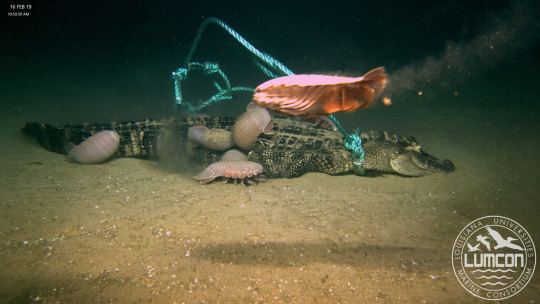
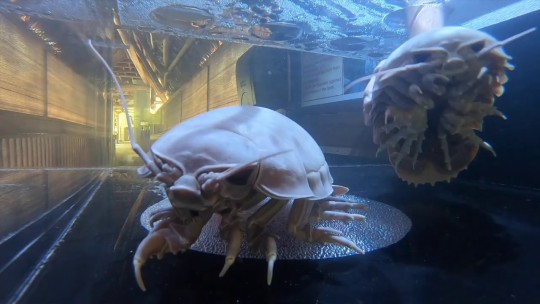


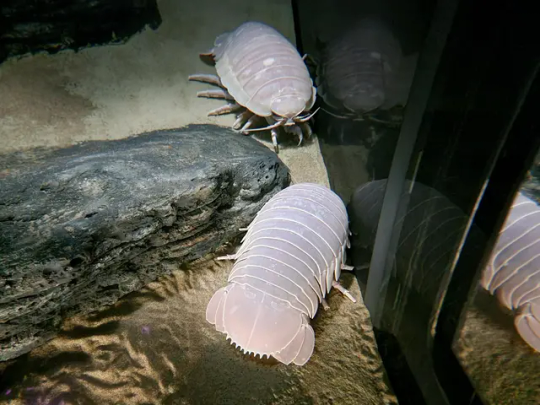
Bathynomus giganteus, more commonly known simply as the giant ispod is a species of aquatic crustacean, in the giant isopods genus Bathynomus and the order Isopoda. As such it is related—albeit distantly—to shrimps and crabs. They are enemdic to the western atlantic ocean, particularly with in the Caribbean sea and gulf of mexico where they prefer cold benthic waters some 1050 to 7050ft (320 to 2150m) below the surface. Bathynomus giganteus is notable for being the first giant isopod known to science, being documented and described in 1879 by French zoologist Alphonse Milne Edwards after the isopod was found in fishermen's nets off the coast of Tortuga. Like many animals that live in the deep sea, giant isopods are scavengers which feed primarily upon detritus, carrion, and other aquatic debris. Reaching 7.5 to up to 20 inches in length, like all crustaceans, it has jointed legs and a hard exterior called an exoskeleton. Three segments make up its body: the head (cephalon), the thorax (pereon) and the abdomen (pleon). It moves about using 14 legs, a fan-like tail called a uropod, and fluttering swimmerets called pleopods. The head possess four jaws, 2 large compound eyes, and two sets of antennae. Breeding tends to occur in winter and spring. Mature females develop a pouch known as a marsupium, where the eggs are stored until the young are ready to emerge as miniatures of the adults, known as manca, completely bypassing a larval stage. Under ideal conditions a giant isopod may live up to 30 years.
#pleistocene#pleistocene pride#pliestocene pride#pliestocene#cenozoic#giant isopod#isopod#deep sea#sea creatures#marine life
70 notes
·
View notes
Text
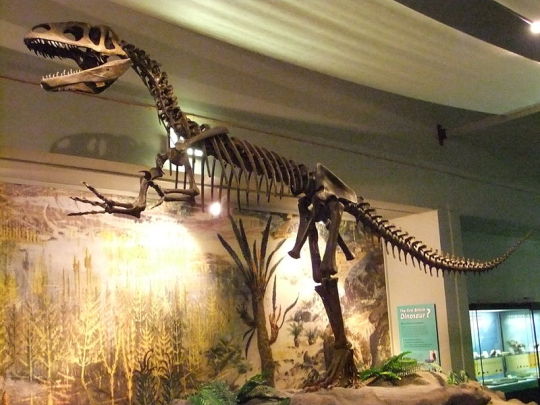

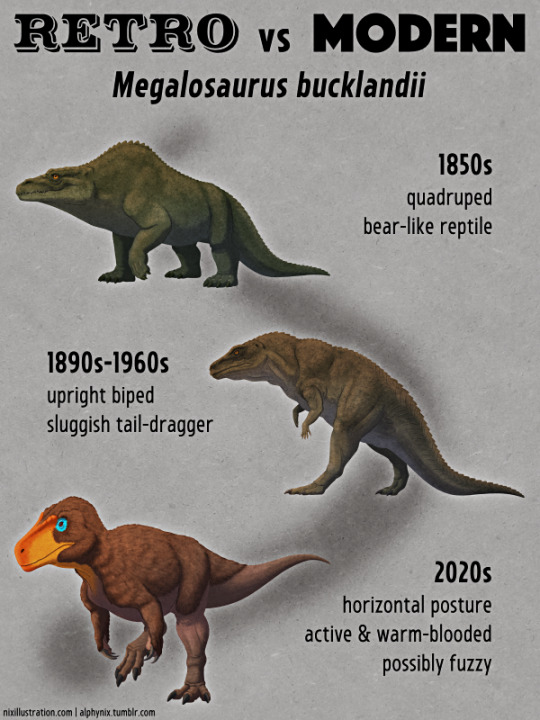

Happy 200th birthday Megalosaurus! Megalosaurus is an extinct genus of theropod dinosaur which lived throughout what is now Europe during the middle Jurassic period some 174 to 163 mya. Although it now only exists in drawings what is thought to be the first fragment of Megalosaurus consisting of a partial femur was discovered in 1676 from a limestone quarry in Oxfordshire by professor Robert Plot, who due to the unprecedented nature of the find, declared it to belong to a biblical giant. In 1763 the bone was given the name 'Scrotum humanum' by Richard Brookes, due to the rather crass yet accurate appearance of the end of the bone to a human scrotum. This name/description was never formerly accepted by any scientific body, but did prompt Rev. William Buckland to begin amassing various other remains from that same Oxfordshire quarry including a piece of a right lower jaw, a thigh bone, ribs, some pelvises, a foot bone, and several vertebrae. After years of study Buckland realized that these specimens all belonged to the same species of giant reptile which he named Megalosaurus meaning great lizard on February 20th 1824. Megalosaurus was 1 of 3 genera which Richard Owen used to found the Clade Dinosaur, marking Megalosaurus as the first non avian dinosaur to be formally described. Over the following centuries over 50 species would be classified as Megalosaurus however nearly all have been determined to belong to other taxa, leaving only the original Megalosaurus bucklandi as valid. Reaching around 20ft in length and 1,500lbs in weight megalosaurus was amongst mid-Jurassic Europe’s largest predators. It had a long tail, strong stout legs, a robust body, short yet muscular arms, and large head, equipped with long curved teeth. In life Megalosaurus would have inhabited tropical forests, wetlands, and coastlines feeding upon fish, invertebrates, amphibians, aquatic reptiles, and other dinosaurs in the island chain that at the time constituted Europe.
Art used belongs to the following creators
Megalosaurus: Julius T. Csotonyi
Megalosaurus through the ages: Nix Draws Stuff
Megalosaurs 200th Anniversary: NazRigar
#pleistocene pride#pliestocene pride#mesozoic#jurassic#megalosaurus#dinosaur#paleoart#200thanniversary#megalosaurus 200th birthday
42 notes
·
View notes
Text
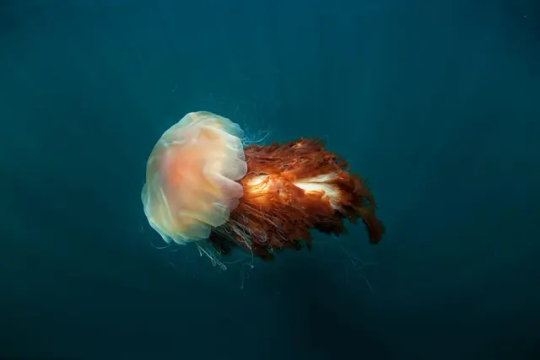


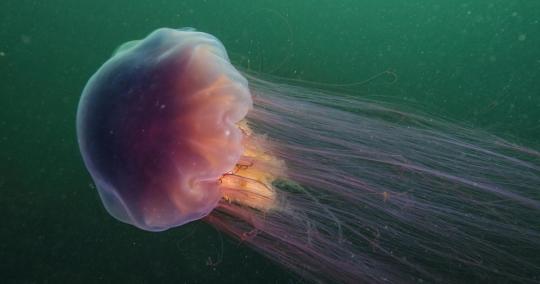
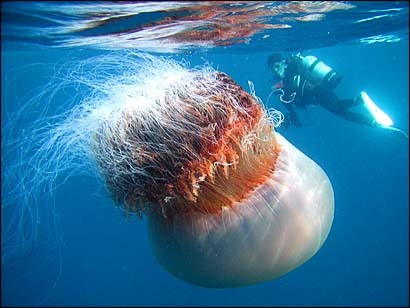



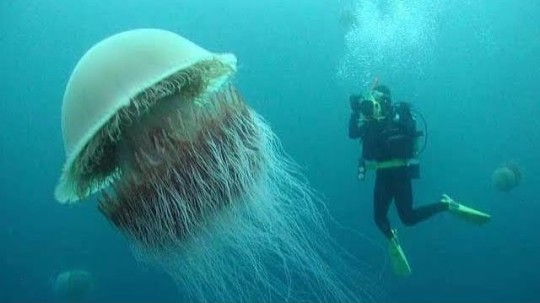
The lion's mane jellyfish (Cyanea capillata), also known as the giant jellyfish, arctic red jellyfish, or the hair jelly is a species of large jellyfish which inhabits the cold, boreal waters of the Arctic, northern Atlantic, and northern Pacific Oceans and is especially common in the English Channel, Irish Sea, North Sea, and in western Scandinavian waters. Lion's mane jellyfish remain mostly very near the surface, at no more than 66ft in depth (20m) depth. Their slow pulsations weakly drive them forward, so they depend on ocean currents to travel great distances. The jellyfish are most often spotted during the late summer and autumn, when they have grown to a large size and the currents begin to sweep them to shore. Unlike most pelagic jellyfish, they are completely solitary and rarely travel in groups. The lion's mane jellyfish uses its stinging tentacles to capture, pull in, and eat prey such as fish, zooplankton, sea creatures, and smaller jellyfish. Lion’s mane jellyfish are themselves eaten by sea birds, sunfish, other jellyfish species, and sea turtles particularly the leatherback sea turtle. Lion's mane jellyfish are named for their showy, trailing tentacles reminiscent of a lion's mane. They can vary greatly in size from a bell diameter of 20 inches (50cms) to upwards of 6.5ft (2m), with tentacles reaching up to 120ft (36.6m) in length making them amongst the longest animals on earth. They vary in coloration from orange, to tan, to red. While most jellyfish such as the moon jelly have a circular bell, the bell of the Lion's Mane is divided into eight lobes, resembling an eight-pointed star. Each lobe contains about 70 to 150 tentacles, arranged in four fairly distinct rows. Along the bell margin is a balance organ at each of the eight indentations between the lobes – the rhopalium – which helps the jellyfish orient itself. From the central mouth extend broad frilly oral arms with many stinging cells called Cnidocytes. Closer to its mouth, its total number of tentacles is around 1,200. Like other jellyfish, lion's manes are capable of both sexual reproduction in the medusa stage and asexual reproduction in the polyp stage. Lion's mane jellyfish have four different stages in their year-long lifespan: a larval stage, a polyp stage, an ephyrae stage, and the medusa stage.
#pleistocene#pleistocene pride#pliestocene pride#pliestocene#ocean#sea#lion#lion's mane jellyfish#mane#jelly#fish#jellyfish#giant jellyfish#red jellyfish#arctic#hair jelly#sea creatures#marine life#cenozoic
75 notes
·
View notes
Text


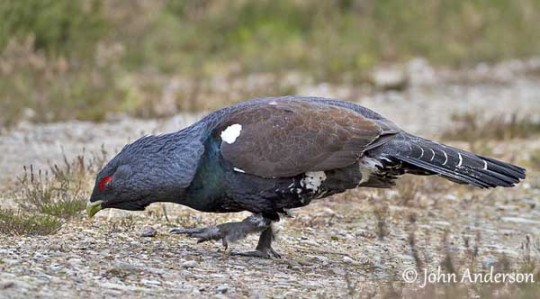




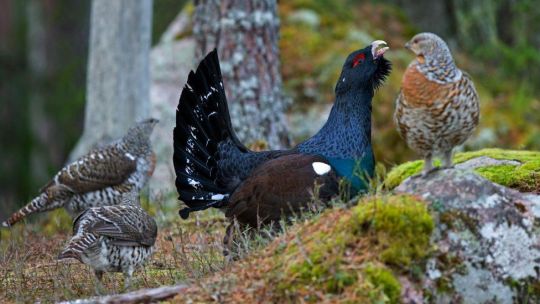


The western capercaillie (Tetrao urogallus), also known as the Eurasian capercaillie, wood grouse, heather cock, cock-of-the-woods, or simply capercaillie is a species in the grouse family which is endemic to the taiga and boreal forest of Northern Eurasia, from Scotland in the west to Russia in the east. They are typically diurnal ground dwelling birds which while capable of flight, are fairly clumsy in the air due to there short rounded wings. While taking off they produce a sudden thundering noise that deters predators. At night they rest in the horizontal branches of tree stands or within thick ground cover such as bushes and sedges, emerging during the day to feed upon seeds, buds, leaves, berries, insects, grasses, and conifer needles. Capercaillies are themselves eaten by wolves, lynx, foxes, eagles, martens, bears, boar, goshawks, and owls. With females reaching around 21- 25 inches (54- 64 cms) long & 3.5 to 5.8lbs (1.5 to 2.5kg) in weight while the male can reach 29 to 40 inches (74 -100cms) long and 9lbs to upwards of 15lbs (4 to 7kg) in weight, the western capercaillie is one of the most size sexually dimorphic living bird species, only exceeded by the larger types of bustards and a select few members of the pheasant family. The females upper parts are brown with black and silver barring; on the underside they are more light and buffish yellow. While the males are dark grey to dark brown, with the breast feathers being dark metallic green. The belly and undertail coverts vary from black to white. Both sexes have a white spot on the wing bow. They have feathered legs, and their toe rows of small, elongated horn tacks provide a snowshoe effect enabling them to traverse thick snow with ease. The breeding season begins in March or April and lasts until May or June. Three-quarters of this long courting season is mere territorial competition between neighboring cocks or cocks on the same courting ground. Towards the end of the courting season the hens arrive on the courting grounds, at which time the dominate cock or cocks flies to an open space nearby and continuously displays. If impressed one or more hens will approach and be mounted. Females will lay 3 to 12 eggs over a 10 day period, which she will incubate for 26 -28 days until hatching. The young will remain with there mother for around 3 months, Under ideal conditions a western capercaillie may live upwards of 18 years.
#pleistocene#pleistocene pride#pliestocene pride#pliestocene#cenozoic#capercaillie#western capercaillie#wood grouse#eurasian capercaillie#bird#birds
39 notes
·
View notes
Text


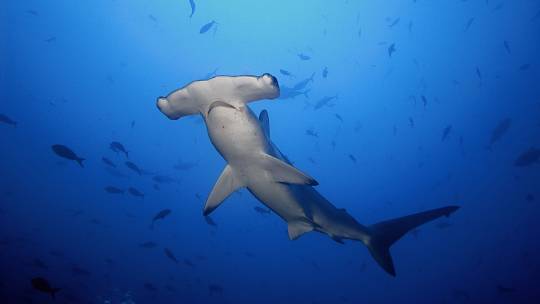



The scalloped hammerhead also known as the bronze, kinky-headed, or southern hammerhead is a species of hammerhead shark in the family Sphyrnidae, which is native to temperature a tropical waters around the globe between latitudes 46°N and 36°S. They tend to inhabit coast lines, bays, mangrove swamps, and continental and insular shelves, from the surface to 1,600ft (500m) deep. They are a moderately social species which lives in pairs or shivers upwards of a hundred strong, typically spending there days close to shore and venturing further out to sea come night fall to hunt prey such as schooling boney fish, squid, octopi, rays, and smaller species of shark such as the blacktip reef shark. Reaching up to 14ft (4.3m) and 335 (152.4kg) in weight, the scalloped hammerhead is easily distinguished from other hammerhead sharks by the central indentation on the anterior margin of the head. There are also two indentations on either side of the central indentation, which gives the "scalloped" look. They have a very large first dorsal fin that is slightly hooked and a smaller second dorsal fin Scalloped hammerhead sharks are typically uniform grey, grayish brown, bronze, or olive with a white underside for countershading. The scalloped hammerhead is also noted for its large and complex brain, with high levels of cognitive capabilities and social intelligence. Mating occurs year round and after a 12 month pregnancy a mother scalloped hammerhead will migrate into shallow coastal bays and mangrove swamps to give birth to 12-41 live pups. Female scalloped hammerheads reach sexual maturity at larger sizes than males. Under ideal conditions a scalloped hammerhead may live up to 30 years.
#pleistocene#pleistocene pride#pliestocene pride#pliestocene#fish#shark#scalloped hammerhead shark#scalloped hammerhead#hammerhead#hammerhead shark#shark week
47 notes
·
View notes
Text

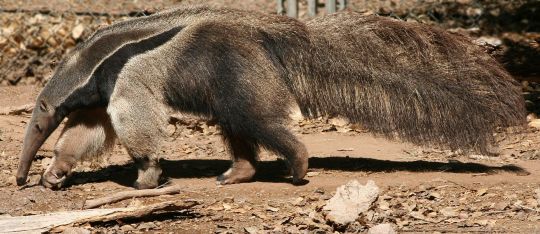
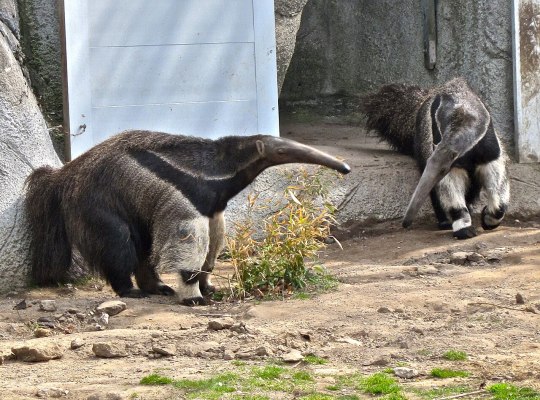
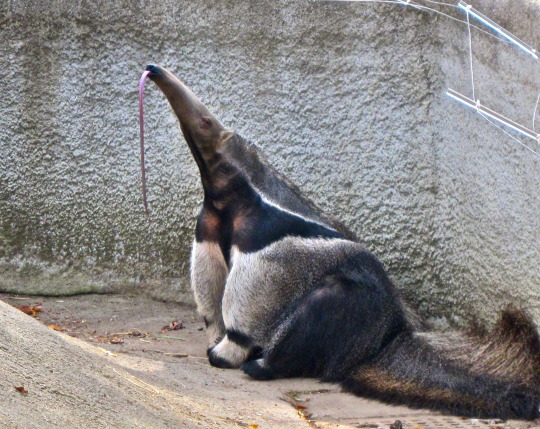
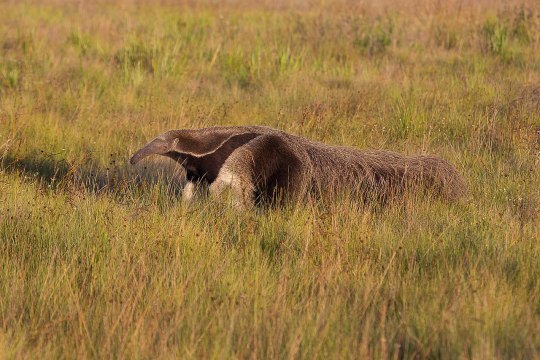



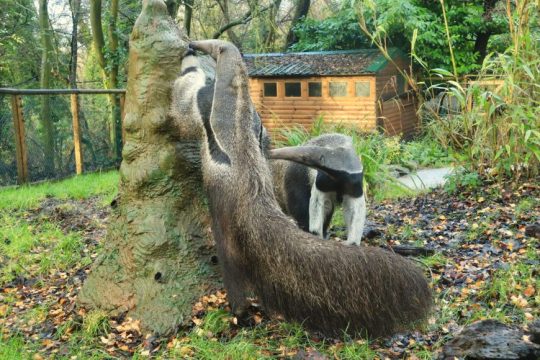

The giant anteater is an insectivorous mammal in the genus Myrmecophaga which is native to Central and South America from as far north as Honduras to as far south as Argentina. Here they generally solitary animals which inhabit rainforests, dry forests, grasslands, and shrublands, and feed primarily upon ants, termites, beetles and there larvae, and honey bees using there long, flexible, sticky tongue. Reaching some 6 to 7ft (182 to 217cms) in length and 60 to 110lbs (27 to 50kg) in weight, the giant anteater is by far the largest of the 4 species of anteater alive today. It is also tied for the position as extant xenarthran only being rivaled by the giant armadillo. The giant anteater has a very distinctive appearance, with a long, tubular snout, small eyes and ears, stocky limbs, long powerful claws, a coarse mane, and a thick bushy tail. They also have a characteristic pattern across their bodies; white front legs, a grey muzzle and a black strip across their chest, throat and shoulders, with bristly, black to brown tails and manes. Mating occurs year round, when two meet up to mate they perform courtship rituals spend several days to weeks mating, traveling, and foraging together. in each other's company to forage. After a 190 day pregnancy a mother will give birth to a single pup; newborns climb onto their mother's back and are carried around by her for the first few weeks of their life. They begin to eat ants and termites at 3 months old and are fully weaned by 10-months. At this age they will leave their mother and become independent, under ideal conditions a giant anteater will reach sexual maturity at 2.5 to 4 years old and may live up to 30.
#pleistocene#pleistocene pride#pliestocene pride#cenozoic#pliestocene#ice age#stone age#giant anteater#anteater#xenarthran
22 notes
·
View notes
Text



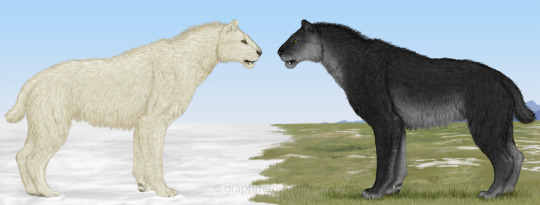

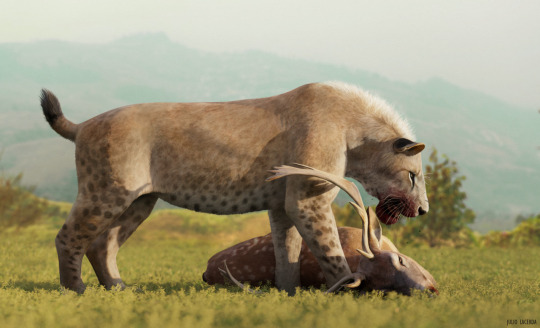


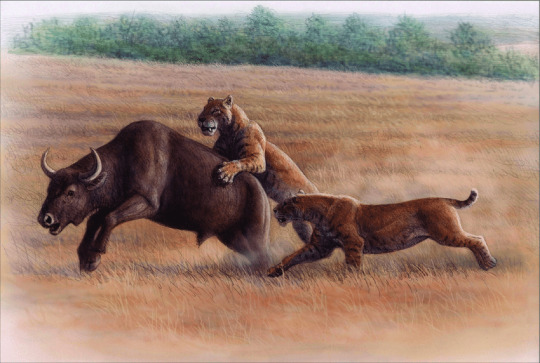

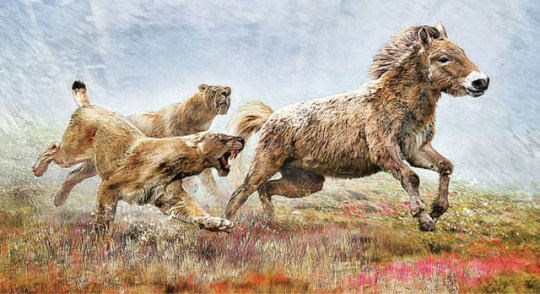
Happy Ice Age Week: Homotherium is an extinct genus of machairodontine scimitar-toothed cat that inhabited North America, South America, Eurasia, and Africa from the Pliocene to the Pleistocene epochs around 4 million to 12,000 years ago. Making them to be one of the most widespread of all felines throughout time second only to the domestic cat. The first fossils known to belong to homotherium consisting of a partial skeleton were described in 1846 by Richard Owen as the species Machairodus latidens. It wouldn’t be until 1890 after several addition specimens where recovered that one Emilio Fabrini would determine them to be a distinct genus which he dubbed Homotherium for the Greek homos meaning same and therion meaning beast. Over the next century and a half hundreds of specimens have been recovered representing over a dozen species including: H aethiopicum, H crenatidens, H crusafonti, H hadarensis, H idahoensis, H ischyrus, H johnstoni, H latidens, H nestianus, H nihowanensis, H sainzelli, H serum, H ultimum, and H venezuelensis. Reaching on average 3.5ft (1.1m) tall at the shoulder and 425lbs (190kg) in weight, homotherium was around the size of a male African lion. Homotherium had shorter upper canines than other machariodonts such as Smilodon or Megantereon, but these were still longer than those of extant cats. The incisors and lower canines of Homotherium formed a powerful puncturing and gripping device, and its jaws were adapted to clamp and hold prey while inflicting damage with the canine teeth. Homotherium is notable for its unusual shape and proportions, with a comparatively compact torso and long legs. They had thick necks, large shoulders, and a sloped back giving them a profile more akin to a hyena than other big cats. These adaptations mean that Homotherium was built for energy efficient travel, and may have used this advantage to wear prey down in a manner similar to how wolves will constantly harass a prey animal until it collapses from exhaustion. This anatomy coupled with findings of multiple homotherium individuals found to have died together, points to Homotherium being a well adapted diurnal social pursuit/ persistence predator.
Art utilized was made by the following creators
Scimitar Toothed Cat: Michael Westbury
https://www.eurekalert.org/multimedia/583429
Homotherium: allotyrannosaurus
https://www.deviantart.com/allotyrannosaurus/art/White-Homotherium-909661018
Homotherium: Mauricio Anton
Homotherium: Julio Lacerda
https://paleoart.tumblr.com/post/629421596985196544/commission-for-a-client-homotherium-latidens-and
#pleistocene#pleistocene pride#pliestocene pride#pliestocene#ice age#cenozoic#ice age week#ice age europe week#homotherium#scimitar toothed cat#fossil#paleontology#mammal
39 notes
·
View notes
Text


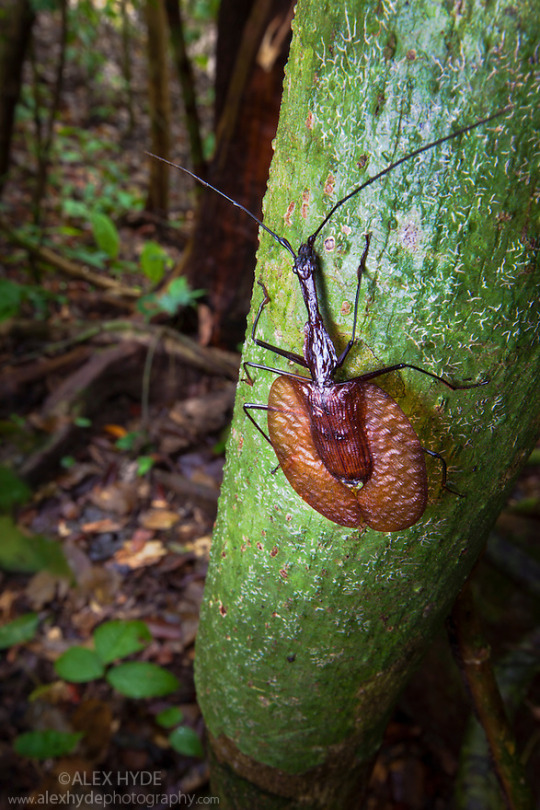
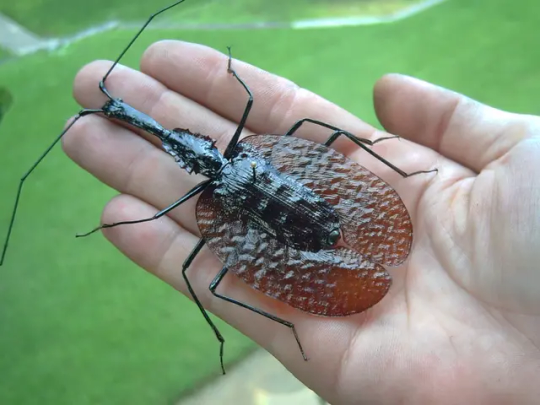


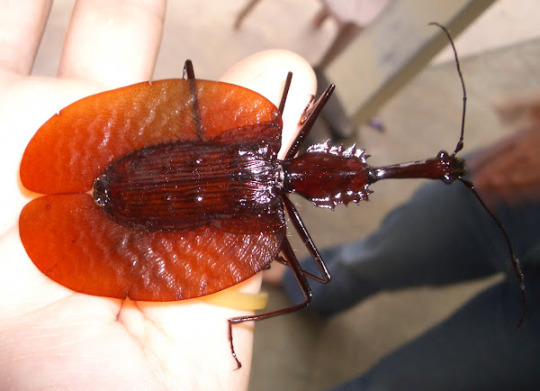

Mormolyce phyllodes, commonly known as the violin beetle, is a species of ground beetles in the subfamily Lebiinae which is native to the tropical rainforests of Southeast Asia including the countries of Brunei, Indonesia, Java, Malaysia, and Sumatra. These typically nocturnal insects spend much of there time living in cracks in the soil, leaf litter, and inside rotten logs or underneath tree bark. Here they primarily feed upon other insects particularly grubs and other larvae. Violen beetles are themselves preyed upon by several species of birds and bats. Because of this in addition to there camouflage they also secrete poisonous butyric acid which they use for defense purposes. Reaching around 2.4 to 3.9 inches (6.1 to 9.91cms) in length, these beetles possess an elongated head and pronotum, slender legs and large antennae. The body is flat and leaf-shaped, typically a shiny black or brown in color with a distinctive violin-shaped translucent elytra hence there common name: the violin beetle. There breeding habits are not well known but they tend to lay there eggs inside of large hard bracket fungi. Upon hatching the larvae spend the next nine months digging tunnels throughout the fungus feeding upon both the fungus and any invertebrates they come across. They then pupate and exit there fungi home. On average adult violin beetles live 3 to 5 months.
#pleistocene pride#pleistocene#pliestocene pride#pliestocene#cenozoic#ice age#stone age#bug#insect#beetle#violin#violin beetle#asia
13 notes
·
View notes
Text

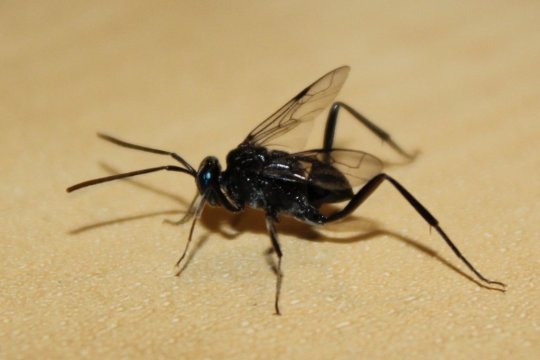






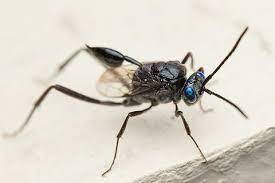
Evania appendigaster better known as the blue-eyed ensign wasp, is a species of wasp in the family Evaniidae, which was originally native to southern asia but has spread throughout much of the worlds tropics, subtropics, and temperate regions and can be now found on every continent barring Antarctica. With adults reaching upwards of .6 inches (15mm) in total length, it is one of the larger ensign wasps and can be distinguished from other species by the wide separation of the first and second sections of the coxa, the segment of the leg that attaches to the body. It sports large wings, and its body is black in color with contrasting blue eyes. The abdominal petiole, the constricted stalk that holds the posterior section of the abdomen, or gaster, is attached high on the body. The gaster is laterally compressed and oval to nearly triangular in shape, held in a flaglike fashion and resembling an ensign, hence the name. This wasp reproduces by laying eggs into egg cases, or oothecae, of cockroaches. The mother wasp sneaks into a cockroach nest then upon finding the eggs, drills a hole into them with her ovipositor and lays a single one of her eggs inside each cockroach egg capsule. The wasp eggs then hatch are there larvae feed upon the cockroach larvae, growing and developing through 5 instars emerging from the now empty egg capsule as an adult. As adults blue-eyed ensign wasps feed primarily upon plants such as parsley and fennel and may live upwards of 3 weeks.
13 notes
·
View notes